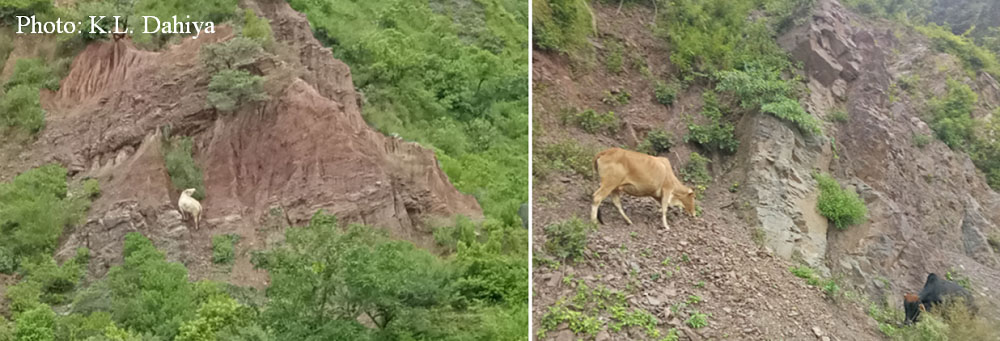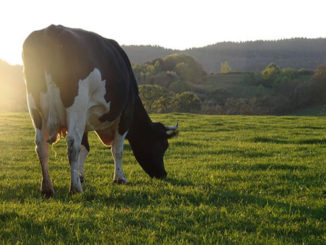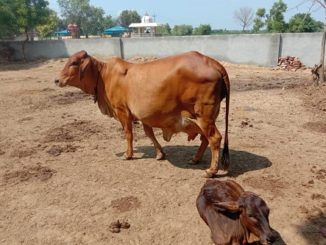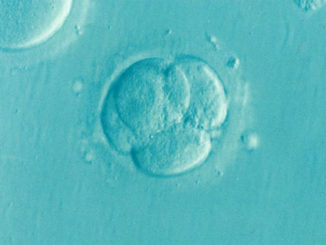Abstract
Morni Hills situated in the lower reaches of Shivalik range, is known to be point of tourist attraction in the Panchkula district of Haryana State. These hills have a wide range of flora and fauna. There are wild and domesticated animals. More than 80 percent households rear the livestock and cattle heads constitutes majority of domesticated animals being well suited to the hilly livestock system as a source of milk, draught and manure in the area.
The Morni hills cattle are small to medium sized animal with compact cylindrical body. Body coat colour varies from black, blackish, brown, grey and white with white face marks extending to the dewlap and brisket in few cattle. Black eye lids with black lashes. Straight forehead with poll tuberosity. Medium sized horns curved in lateral or forward and upward direction. Horizontally placed ears with pointed tips, black muzzle. Black switched comparatively long tail, medium sized hump. No or negligible naval flap. Short legs with black or grayish black hooves. Bowl or trough shaped udder with small to large milk vein and cylindrical and small to medium sized teats. The peak milk yield varies from 2.0–4.0 kg per day. The height at shoulder, hump and rump varies from 94–100, 96–108 and 100–106 cm respectively. Heart girth, length from point of shoulder to pin bone, length from head to pin bone and body weight varies from 120–138, 95–116, 118–162 cm and 120–220 kg respectively in adult cattle.
The Morni hills cattle appears to be similar to Himachali Pahari cattle bearing a clear distinction from rest of the Haryana state cattle viz. Hariana, Sahiwal, Mewati, Belahi etc. These are the findings which have been recorded first time and need further validation of the work.
Keywords: Morni Hills Cattle, Shivalik range, Smallest Cattle, Haryana, Himachali Pahari cattle.
The livestock population in India includes cattle, buffaloes, sheep, goats, horses & ponies, camels, pigs, mules, donkeys and yaks (apart from poultry, dogs and rabbits), comprises 536.76 million. In India, the cow is considered as a holy cow and worshipped by every Hindu. As per livestock census conducted in 2019, there are 193.47 million cattle heads which constitutes 36.04 per cent of Indian livestock population (GOI 2019). There are 50 distinct registered breeds of cattle in India (NBAGR 2020) comprising 142.11 million indigenous cattle heads (GOI 2019). These indigenous described cattle breeds are well adapted across varied agro–climatic conditions of India. However, there is a huge cattle genetic resource waiting for distinction in India, particularly the migratory cattle. It is also the fact that these non–descript cattle are playing most crucial role in securing livelihood and in the well–being of the traditional rural livestock farmers. It is well documented that Indian cows (Bos indicus) are have unique morphological characters as compared to exotic (Bos taurus) one. Indian cattle are more summer heat tolerant as well better immunity against tick and tick borne diseases including other exotic diseases.
Comprising 14 bhojas (old provincial territories), Morni Hills situated in the lower reaches of Shivalik range, is known to be point of tourist attraction in the Panchkula district of Haryana State. The Bhoj Tikkar Taal, with the beauty of nature and blessed with two lakes, is the main attraction for tourists. It is a drought prone, rain–fed area but favourable climate for vegetable cultivation provided the facility of assured irrigation by tapping base flow from natural springs located in the mountainous hilly forests. These hills have a wide range of flora and fauna. There are wild and domesticated animals.
The cattle, buffalo and goat constitute the major livestock wealth in the hilly range of the area. More than 80 percent households rear the livestock and cattle heads constitutes majority of domesticated animals being well suited to the hilly livestock system as a source of milk, draught and manure in the area. Although, milk production of the reared cattle and buffaloes is too low however they are mainly milch type. The bullocks of local indigenous breeds, purchased from lower plains are used in agricultural activities.

Though, these cattle in the lower hilly region had got mixed with local (particularly Belahi) and exotic breeds for upgrading their productivity. However, in the upper hills of the region, true type hill cattle which are homogenous for typical morphological characteristics are still found in the substantial numbers.
Home tract
The Morni hills cattle is non descript cattle mainly reared in the rural area of Morni Hills situated in the Shivalik Hills range of Panchkula district of Haryana state, from 300–1100 meter altitude height, adjoining the Himachal Pradesh in the north.
Synonyms
Being non descriptive, there is no specific name for the Morni hills cattle. However, they are recalled as deshi or pahari gai (cattle) by the local people.
Morphological characteristics
- Body: These cattle are small sized and have compact conformation with slight distended abdominal area.
- Body colour: The coat colour in these cattle is true solid. The coat colour patterns are brown (light to dark) in majority of the cattle, reddish, black, black-brown, reddish-brown, white, grey and other mixed type. In some of the cattle brown with black splashes. In too small numbers white face is also seen just like to Belahi cattle of Shivalik foothills.
- Skin: Soft and tight
- Head: Head with prominent poll tuberosity.
- Forehead: The forehead is predominantly straight in all cattle.
- Face: Slender
- Muzzle & Nares: The predominant muzzle colour is black (more than 90 per cent) but brownish-black, brown and pinkish-brown is also observed in some animals. The nares are encircled with light (white) coloured skin and hairs around the muzzle.
- Eyes: In majority of the cattle eye lid colour is black but whitish-black is also seen in some animals. The black lashes are predominant in all the cattle.
- Limbs: Short legs.
- Horns: Horn shape is predominantly curved in more than 80 per cent followed by straight in 20 percent cattle. The orientation of horns is laterally forwarded in more than 50 per cent followed by lateral upwards in 40 per cent cattle heads. The predominant horn colour is blackish white in more than 63 per cent, followed by black (27 per cent) and brown (10 per cent) in cattle.
- Ears: Horizontally placed ears with pointed tips.
- Neck: Short, thicker in males than females.
- Dewlap: Well developed
- Shoulder hump: Small but distinctly developed hump.
- Naval flap: The naval flap predominantly absent (if present then negligible) among all the cattle.
- Tail: In majority of cattle the tail reaches beyond the hocks mainly black switch in colour in more than 90 per cent cattle and a mixture of black and white in some animals also seen.
- Hooves: In majority of cattle the hoof colour is whitish-black (more than 70 per cent) and other it is black.
- Udder: The udder is predominantly bowel shaped udder with medium (~55 per cent), small (~25 per cent) and large (~20 per cent) sized milk vein. The predominantly cylindrical shaped teats with round tips present in all the cattle. The teats are medium sized (3-5 cm) in 80 per cent, followed by large (10 per cent) and small (10 per cent) sized teats.
Morphomtric parameters
- Body weight: The body weight in adult animals varies from 120–220 kg. However, majority (73 percent) of animals bear more than 150 kg body weight.
- Height: The height at hump varies from 94.0-120 cm whereas it is 91.0-115.5 cm excluding hump. Predominantly it is more than 100.0 cm (including hump) and more than 91.0 cm (excluding hump) in more than 90 per cent cattle. The height at rump is nearly more than 100 cm and less than 100 cm in more or less than 90 and 10 percent cattle, respectively.
- Body length: The body length from head to pin bone varies from 118.0 – 162 cm.
- Heart girth: The heart girth varies from 120-155 cm. However, more than 50 percent cattle possess heart girth between 120-140 cm.
Production traits
The daily milk production varies from 2.5-4.5 kg but majority of cows yield 2.0-4.0 kg in their peak lactation.
Behaviour of the animals
Majority of animals are let loose to mountainous pastures during the sunny hours of the day and kept stanchioned at evening for the whole night. Though, during day hours, the animals are kept loose, however, they bear a moderate behaviour.
Milk and milk by-products
The cattle are reared only for milk and that is for home utility and not sold to earn extra income. It is used as fresh and for the preparation of curd and clarified fat for home. Morni hills, being a tourist place in the lower hills in Northern Haryana, the produced milk also used at tea stalls for hot beverage preparation at shops run by local people.
Adaptation
The Morni Hills cattle possess the unique qualities related to better thriving and adaption to the mountainous cliffs of the area. It is well adapted to cold weather of the region. It can thrive on low quality grasses mainly survive on mountainous pastures. Some of the mineral deficient cattle lick the rocks too. Some cattle, particularly the milch animals are also offered as stall feeding.

Disease resistance
It has been observed that these cattle are not affected with any contagious disease. It may be due to their genetic constitution as well as their grazing habits. It is least affected with contagious diseases particularly the Foot & Mouth Disease Virus and haemorrhagic septicaemia.
The small cattle breeds in India
India is the home vast biodiversity and possesses 50 distinct registered breeds of large, medium and small breeds of cattle. Vechur is the smallest cattle breed found in India and Bachaur, Badri, Bargur and Himachali Pahari cattle are among the other small breeds. The Haryana state already possesses four descriptive breeds of cattle viz. Hariana, Sahiwal, Mewati and Belahi. The Morni hills cattle, a non-descript cattle breed found in the lower shivalik hills of Himalaya, is smallest from the rest of cattle breeds in the Haryana, and appears similar to Himachali Pahari cattle of Himacha Pradesh (Verma 2012, NBAGR 2020).
Summery
The Morni hills unique attraction spare sometime enjoyable events in the mountainous hills of lower Himalaya. The region is enriched natural beauty flourished with rocky cliffs, green vegetation, flora and fauna. The people of the region bear good moral values and nurtured with nature for “Guests are alike God”. Being cow is considered as Holy creature, so people take care well not only the cattle but also the other animals, too. The locally available cattle in the region possess unique qualities to thrive and survive in the hills. These are the findings which have been recorded first time and need further validation of the work.
Disclaimer
It is not a scientific study. The provided data is based on small population. However, it seems to be unique germplasm found in the Morni hills of Northern Haryana and needs scientific evaluation.
References
- GOI, 2019, 20th Livestock Census–2019, All India Report. Govt. of India. Ministry of Fisheries, Animal Husbandry & Dairying. Department of Animal Husbandry & Dairying. Animal Husbandry Statistics Division. Krishi Bhawan, New Delhi. [Web Reference]
- NBAGR, “REGISTERED BREEDS OF CATTLE,” ICAR- National Bureau of Animal Genetic Resources (NBAGR); assessed on December 13, 2020. [Web Reference]
- NBAGR, 2020. Thirteen New Breeds of Indigenous Farm Animals and One Line of Chicken Registered by ICAR-National Bureau of Animal Genetic Resources, Karnal. [Web Reference]
- Verma D., 2012, Chraterization of Local Indigenous Cattle of Himachal Pradesh. Doctoral dissertation, CSKHPKV, Palampur. [Web Reference]







Be the first to comment